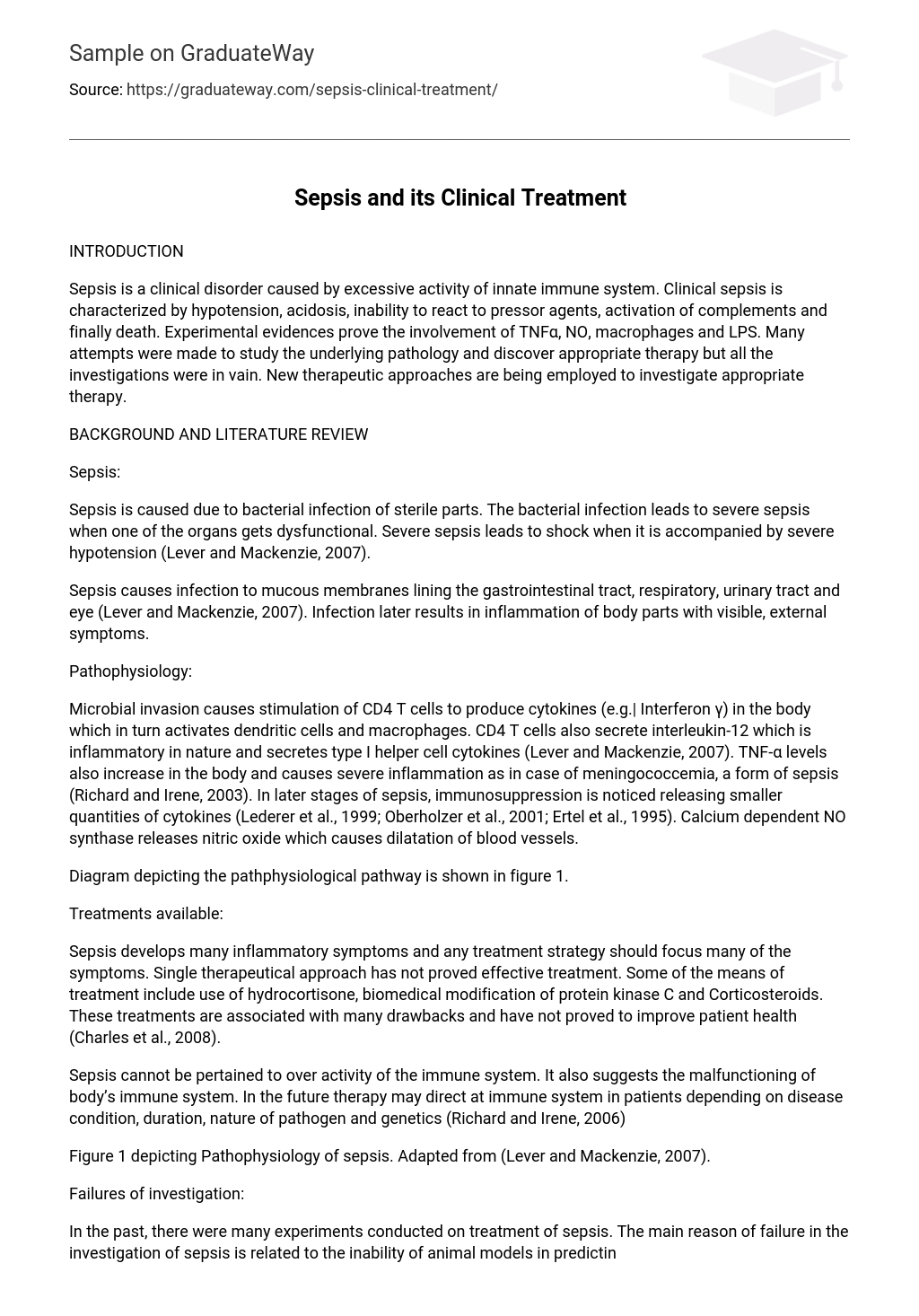INTRODUCTION
Sepsis is a clinical disorder caused by excessive activity of innate immune system. Clinical sepsis is characterized by hypotension, acidosis, inability to react to pressor agents, activation of complements and finally death. Experimental evidences prove the involvement of TNFα, NO, macrophages and LPS. Many attempts were made to study the underlying pathology and discover appropriate therapy but all the investigations were in vain. New therapeutic approaches are being employed to investigate appropriate therapy.
BACKGROUND AND LITERATURE REVIEW
Sepsis:
Sepsis is caused due to bacterial infection of sterile parts. The bacterial infection leads to severe sepsis when one of the organs gets dysfunctional. Severe sepsis leads to shock when it is accompanied by severe hypotension (Lever and Mackenzie, 2007).
Sepsis causes infection to mucous membranes lining the gastrointestinal tract, respiratory, urinary tract and eye (Lever and Mackenzie, 2007). Infection later results in inflammation of body parts with visible, external symptoms.
Pathophysiology:
Microbial invasion causes stimulation of CD4 T cells to produce cytokines (e.g.| Interferon γ) in the body which in turn activates dendritic cells and macrophages. CD4 T cells also secrete interleukin-12 which is inflammatory in nature and secretes type I helper cell cytokines (Lever and Mackenzie, 2007). TNF-α levels also increase in the body and causes severe inflammation as in case of meningococcemia, a form of sepsis (Richard and Irene, 2003). In later stages of sepsis, immunosuppression is noticed releasing smaller quantities of cytokines (Lederer et al., 1999; Oberholzer et al., 2001; Ertel et al., 1995). Calcium dependent NO synthase releases nitric oxide which causes dilatation of blood vessels.
Diagram depicting the pathphysiological pathway is shown in figure 1.
Treatments available:
Sepsis develops many inflammatory symptoms and any treatment strategy should focus many of the symptoms. Single therapeutical approach has not proved effective treatment. Some of the means of treatment include use of hydrocortisone, biomedical modification of protein kinase C and Corticosteroids. These treatments are associated with many drawbacks and have not proved to improve patient health (Charles et al., 2008).
Sepsis cannot be pertained to over activity of the immune system. It also suggests the malfunctioning of body’s immune system. In the future therapy may direct at immune system in patients depending on disease condition, duration, nature of pathogen and genetics (Richard and Irene, 2006)
Figure 1 depicting Pathophysiology of sepsis. Adapted from (Lever and Mackenzie, 2007).
Failures of investigation:
In the past, there were many experiments conducted on treatment of sepsis. The main reason of failure in the investigation of sepsis is related to the inability of animal models in predicting therapeutic efficacy.
The reasons accounted for this are:
• Many inflammatory mediators available which caused confusion.
• Inappropriateness of study model and inability to reflect studies in human models (Charles, 2004).
• Inefficiency of experiments based on pretreatment protocol.
• Majority of bacterial infections causing sepsis are gram positive which produce many exotoxins that activate immune system.
All the factors demanded thorough knowledge and new challenges in research.
AIMS AND OBJECTIVES:
The proposal intends to address the challenges posed in the field of research by implementing strategic approaches to treat sepsis.
POTENTIAL METHODS TO ADDRESS OBJECTIVES
Numerous studies are under investigation. These include:
* Screening patients regularly: Since the progress of symptoms is rapid in sepsis patients, regular screening is an essential approach. This is useful to study the response of excess cytokines and LBP to injected LPS. Genetic polymorphism amongst the patients could be given emphasis and early stages of infection could be treated.
* Increase in knowledge of immune system: There are dynamic changes involved in the immune system and parasympathetic nerve at different stages of sepsis. Having a better knowledge in immune system changes in this condition would play an important role in research e.g. activation of splenic nerves would prove beneficial effects.
* Early phase cytokines and Late phase cytokines: Early phase cytokines are not involved in death in sepsis. Late phase cytokines cause death and HMGB-1 acts as a pro-inflammatory protein mediator causing death. This could be identified after many hours of LPS injection in experiments.
* Selective targeted therapy: Using targeted therapy allows utilization of treatment measures according to the patient condition. Examples include rising procalcitonin levels when receptor antagonists are used. Use of activated protein C to evaluate risk in sepsis patients (Richard and Irene, 2006)
CONCLUSION:
Drug discovery in chronic conditions like sepsis poses a great challenge for pharmaceutical companies. However, promising results lead to a new innovation in health care and becomes a boon to many patients suffering from sepsis.
When the studies under investigation are addressed by quality research work, success would be at forefront for any pharmaceutical company.
REFERENCES:
1. Lederer, J.A.,Rodrick, M.L., Mannick, J.A. (1999)The effects of injury on the adaptive immune response. Shock.11, pp.153-9.
1. Oberholzer, A., Oberholzer, C., Moldawer, LL. (2001) Sepsis syndromes: understanding the role of innate and acquired immunity. Shock.16, pp.83-96.
1. Andrew, L., Iain,M. (2007) Sepsis: definition, epidemiology, and diagnosis. BMJ 335, pp. 879-83.
1. Richard, S., Hotchkiss., Irene, E., Karl. (2003) The Pathophysiology and Treatment of Sepsis. n engl j med. 348(2).
1. Ertel, W., Kremer, J-P., Kenney, J. (1995) Downregulation of proinflammatory cytokine release in whole blood from septic patients. Blood. 85, pp.1341-7.
1. Charles, L. S., Djillali, A., Didier, K., Rui, M., Mervyn, S., Klaus, F., Didier P. (2008) Hydrocortisone Therapy for Patients with Septic Shock. n engl j med. 358(2).
1. Charles, T. (2004) Why do animal models (sometimes) fail to mimic human sepsis? Crit Care Med. 32(5).





